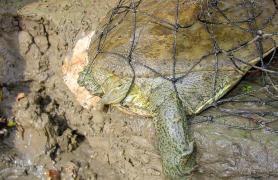Hercules won his battle with Hydra, the mythical many-headed sea serpent. MDC aquatic biologists believe they can defeat hydrilla, an invasive water plant with many ways to reproduce and grow into thick mats that choke ponds, lakes, and rivers. But help is needed from anglers, boaters, and private pond owners to keep this new invasive threat at bay. Missouri’s treasured fishing waters are at stake.
Still Time to Stop its Spread
Already, sharp-eyed citizens who spotted hydrilla and reported it to MDC have helped put the brakes on infestations found in the Springfield, Johnson County, and St. Louis areas. The green, whorled plant with serrated leaves has the potential to spread rapidly and ruin waters for anglers and boaters. In addition, hydrilla can harbor toxins that can kill waterfowl and raptors. Infestations can clog intakes for drinking treatment plants or irrigation equipment. Early detection can help MDC and property owners prevent hydrilla from becoming established. “Hydrilla can cost us a fortune, and it can ruin the fishery in many of our lakes,” said Kenda Flores, MDC aquatic habitat specialist. “It can change things drastically.”
Several invasive species, both plant and animal, on land and in water, are major threats to Missouri’s fish and wildlife. Controlling them is a top priority in MDC’s strategic plan. Stopping hydrilla, however, is drawing special attention because the prolific, rampantly growing plant is among the most threatening to healthy fisheries and avian wildlife. Yet it’s currently been found in only five Missouri counties, so there’s still time to prevent millions of dollars in eradication costs and lost fishing opportunities for anglers.
A Complex Invader
The Eurasian native escaped from the aquarium trade and invaded Florida waters in the 1950s. Then hydrilla spread to other locations, including some large reservoirs in Southern states. The plant is especially fond of warm, clear water. “Florida and Texas combined spend more than a billion dollars annually just to keep boat lanes open from launch ramps, so anglers and boaters can reach open water,” Flores said.
The challenge is to stop a plant that can grow an inch a day and has multiple ways to sprout into new stands and reach new waters. Hydrilla can sink roots and grow from the shoreline to water 30 feet deep. A new plant can sprout from small fragments of leaves and stems as well as seeds. Buds that grow at the leaf axil, called turions, can start new plants. So can potatolike tubers that grow on the roots. Turions and tubers can embed in mud and enable hydrilla to bounce back from winter. They pose the most problems for controlling hydrilla.
The tubers are not killed by herbicides. Wildlife, floods, water current, boats, trailers, fishing tackle, and hunting gear such as decoys can all move hydrilla to new places. So can the illegal sale of hydrilla as an aquarium plant, or the accidental transfer of tubers or turions in soil with potted plants traded or sold for water gardens.
Other aquatic plants producing thick growth pose similar problems for ponds and lakes. Most of those native and nonnative plants can be controlled or eliminated in ponds and smalllakes with one or two treatments. Once hydrilla gets established, however, treatments are needed for five years or more because the treatments will kill green vegetation but not tubers on the roots. Tubers can survive that long in a pond’s gravel, sand, or mud sediment and produce new hydrilla plants. Annual herbicide treatments to control hydrilla can cost from $200 to more than $2,000 per acre, said Kara Tvedt, MDC fisheries management biologist.
“It is very site-specific,” Tvedt said. “Small ponds with limited water exchange can be treated with cheaper formulations and at lower rates. Sites with high water exchange rates and spot treatments in reservoirs require more expensive herbicide formulations and higher rates. Depth also plays a role in the amount of herbicide needed. As you would expect, deeper lakes have more volume, so more product is need to achieve the desired herbicide rate.”
Hydrilla in Missouri
Hydrilla was first discovered in Missouri in 2012 at a private 9-acre lake in Greene County. MDC and property owners are now monitoring 33 ponds or lakes in Greene County where hydrilla has been found. Two sites were found before tubers were produced and received one treatment. But 31 sites had tubers and are getting annual treatments. The invader has also been found at a private pond in Dallas County.
A few strands of hydrilla were found last July in the upper end of Fellows Lake, which serves Springfield’s drinking water supply. Hydrilla was likely washed into the lake from a pond in the watershed by heavy rains during April 2017. MDC and City Utilities of Springfield responded quickly, and hopefully, they eliminated the plant before it had a chance to put down tubers. No tubers have been found thus far, which is encouraging, and the lake will get intense monitoring this summer.
MDC staff works with property owners to monitor waters in neighborhoods where hydrilla is found.
“You’ve got to try to find every spot of it and treat it because it moves so easily,” Tvedt said.
One pond in Greene County likely got hydrilla from people dumping fish, plants, and water out of aquariums they no longer wanted, Tvedt said. At another pond, the previous owners fished in Southern states where hydrilla is common. It’s possible the owners returned with the plant clinging to their boats or equipment. Some infestations may have started from tubers in soil around potted plants like water lilies placed in ponds.
In Warren County, hydrilla was discovered in a subdivision pond. It was likely introduced from tubers in soil with potted water lilies purchased for the pond. In a separate case, a business in St. Louis County was found selling hydrilla as a water-garden plant with a sales pitch that it adds oxygen to water. Hydrilla is a federally listed noxious weed in the United States, which means it is illegal to sell or plant it. The U.S. Department of Agriculture Animal and Plant Health Inspection Service contacted the business and halted the sales.
In 2016, a citizen helped discover an accidental hydrilla infestation at a lake at Powell Gardens, a nonprofit botanical garden east of Kansas City in Johnson County. That summer, the person had seen an MDC invasive species display at the Missouri State Fair. The citizen realized hydrilla was growing at Powell Gardens and notified garden staff. The invader apparently arrived in water lilies purchased as potted plants and placed in the lake two or three years prior.
“It was a warning sign to us that we need to be more vigilant in the future,” said Kalie Hudson, Powell Gardens manager for marketing and sales. “It was definitely a surprise.”
MDC urges people purchasing aquatic plants for a water garden or pond to clean all roots and discard any soil from pots. People should plant bare-root plants in a pond, or if a pot is used, replace the soil with clean material.
Similar care is needed for aquariums. When discarding aquarium fish and plants, they should never dump them into ponds or lakes. Sparing a few exotic fish and plants can destroy the quality of a native fishery. Place unwanted aquarium plants, soil, sand, or gravel in a bag and freeze for at least two weeks before disposing in trash. Do not compost this material. Hydrilla covered much of Powell Garden’s main lake when treatments began, said Trish Yasger, MDC fisheries management biologist. The herbicide was applied from a boat at the lake and from the shore at two nearby ponds.
“There was not a lot of open water,” Yasger said of the main lake. “We were trying to apply the chemical. The hydrilla kept mdc.mo.gov 27 clogging the trolling motor, and it was hard to paddle through. It was just thick.”
MDC sent letters to landowners in the area alerting them that hydrilla was found in the neighborhood. MDC staff will regularly check the streams in the area, and biologists are willing to inspect ponds if property owners think hydrilla might be present.
“We looked at several ponds last year, and none of them had hydrilla — thankfully,” Yasger said.
Protecting our Waters
Anglers and other recreationists can help stop movement of aquatic invasive species, including other plants or zebra mussels, by draining, cleaning, and drying boats, motors, and trailers. The same for fishing and hunting gear. Waterfowl hunters need to make sure plants don’t move on gear such as decoy lines and weights or that tubers move on muddy boots. Precaution and prevention are easier and far more affordable than treatments. MDC staffers power wash boats with hot water after applying treatments in lakes or ponds that have hydrilla or other invasive species.
“If you launch a boat in water and pull it out, it’s important to get all the vegetation off the boat and trailer,” Yasger said. Anglers should never move hydrilla on purpose. At large reservoirs in Southern states, largemouth bass are often caught near hydrilla mats. But that’s often because the open water on the edges of those mats is the only place where anglers can fish. Also, studies have found that the average weight of largemouth bass decreases by 30 percent in impoundments with hydrilla, Tvedt said. The thick growth blocks so much sunlight that less food is produced at the bottom of the food chain and bass have less to eat.
“Studies have shown hydrilla causes a decrease in the average size of fish,” Tvedt said.
In Southern states, hydrilla has also been found to harbor a type of cyanobacteria, or blue-green algae, that is toxic to waterfowl and birds of prey, such as bald eagles, that eat them. University of Georgia researchers found the cyanobacteria that causes avian vacuolar myelinopathy and named it Aetokthonos hydrillicola. The translation from the scientific name means eagle killer that lives on hydrilla. Avian vacuolar myelinopathy was first identified in Arkansas in 1994 after being tied to eagle deaths. The toxin causes unique holes in the brain and spinal cords of the birds, impairing their walking, swimming, and flying, and eventually causing death. Despite hydrilla’s ability to spread in multiple ways and cause a variety of problems, MDC and conservation partners — including outdoor enthusiasts — are doing all they can to stop its spread in Missouri. “If we can catch it early and get it under control and halt its movement, we have a shot,” Tvedt said. “We have a good shot.”
Don’t Dump Aquariums or Bait, and Always Clean Your Gear
Dumping unwanted aquariums and bait buckets into ponds, lakes, or streams spreads invasive species. Take care to clean, drain, and dry all watercraft and gear when moving from one body of water to another. This practice can halt the spread of all invasive aquatic species, including zebra mussels, Asian carp, and various unwanted aquatic plants.
To learn more about invasive species, visit short.mdc.mo.gov/Z5L.
Report and Control Hydrilla
Learn what the plant looks like, and if you find it, please email several in-focus, close-up photos to hydrillareporting@mdc.mo.gov. For hydrilla identification and prevention tips, visit short.mdc.mo.gov/ZTr. MDC staff can help you plan a strategy to eliminate hydrilla from your pond or lake. They also monitor treatment sites, including sampling sediment and looking for tubers that can sprout new plants. In addition, they monitor creeks and streams where ponds have hydrilla. The goal is to ensure that heavy rains don’t flush hydrilla into streams and cause infestations.


















Also In This Issue


And More...
This Issue's Staff
Associate Editor - Bonnie Chasteen
Staff Writer - Larry Archer
Staff Writer - Heather Feeler
Staff Writer - Kristie Hilgedick
Staff Writer - Joe Jerek
Creative Director - Stephanie Thurber
Art Director - Cliff White
Designer - Les Fortenberry
Designer - Marci Porter
Photographer - Noppadol Paothong
Photographer - David Stonner
Circulation - Laura Scheuler






















